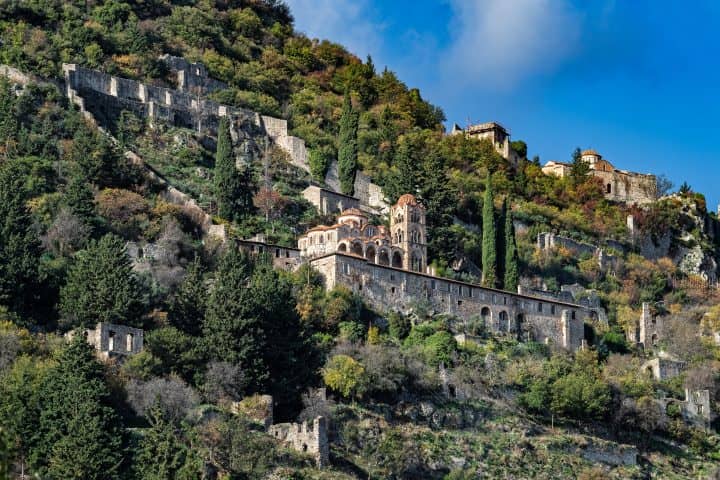 Mystras is one of the most remarkable archeological sites in the world. Built as a fortress by the Frankish Prince William II of Villehardouin in 1249, Mystras is situated in the southeastern part of the Peloponnese and overlooks the city of Sparta. As time went by, Mystras became one of the jewels of the Byzantine Empire, renowned for its architecture and contributions to Byzantine culture. Officially recognized in 1989 as a UNESCO World Heritage Site, Mystras is now visited by countless tourists each year hoping to get a peek of the city’s medieval splendor and cultural heritage.
Mystras is one of the most remarkable archeological sites in the world. Built as a fortress by the Frankish Prince William II of Villehardouin in 1249, Mystras is situated in the southeastern part of the Peloponnese and overlooks the city of Sparta. As time went by, Mystras became one of the jewels of the Byzantine Empire, renowned for its architecture and contributions to Byzantine culture. Officially recognized in 1989 as a UNESCO World Heritage Site, Mystras is now visited by countless tourists each year hoping to get a peek of the city’s medieval splendor and cultural heritage.
History of Mystras
Frankish forces ceded control of Mystras to Byzantine in 1262, after which the fortress became the seat of government for the Morea, the Byzantine name for the Peloponnesian peninsula. For almost a century, the region was in a constant state of warfare as Frankish knights attempted to regain control of the area. This warfare forced the residents of many nearby cities to seek sanctuary behind the walls of Mystras, increasing its preeminence in the region.
Beginning in 1349, Byzantine emperors established Mystras as the capital of the Despotate of the Morea. The position of despot was given to the sons of Byzantine emperors before ascending to the high throne and continued until the city’s capture by the Ottoman Turks in 1460. Mystras’s time as a royal capital is regarded as the city’s golden era. In addition to longstanding peace, Mystras also saw a flourishing of culture under the despots.
The city continued under Ottoman rule until 1821. During this age, many catastrophes led Mystras to ruin. The city was partially destroyed in 1770 during the Orlov Revolt and looted once again by Egyptian forces during the Greek War of Independence in 1823, after which residents abandoned the city.
Architecture of Mystras
At its height, Mystras was home to some of the finest architecture in the Byzantine Empire. The city’s architecture is a mix of Helladic design, which is rooted in the traditions of southern Greece, and styles popular in the Byzantine capital of Constantinople. Owing to Mystras’s status in the era as a major trade hub, architecture in the city is further influence by Gothic and Romanesque styles popular in the West. Among the finest examples of architecture in Mystras is the Hagios Demetrios, the oldest church in the city and its ecclesiastical capital. Churches like the Hagios Demetrios were adorned with frescoes that art historians of the modern age point to as fine examples of the Palaeologan Renaissance of the 13th and 14th Centuries.
Taking a Tour of Mystras
Tourists interested in visiting Mystras often focus their excursions on exploration of the city’s major ruins. While the city’s churches get most of the attention, experts also suggest visiting other areas, including some of the city’s ancient manors and palaces. In addition to Mystras’s historical significance, visitors to the site are also treated with spectacular views of the surrounding countryside as the site rests on a large hill. The site’s close proximity to Sparta further affords it easy access to any visitor exploring Greece.
The archeological site of Mystras is a gem for those hoping to learn more about medieval Greece and the country under Byzantine rule. While visitors of Mystras will leave with a greater understanding of the city’s rich history, they will also enjoy some of the best preserved ruins in the world while beholding picturesque views of the Greek countryside.

